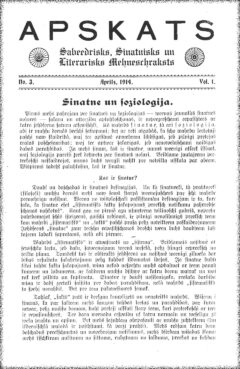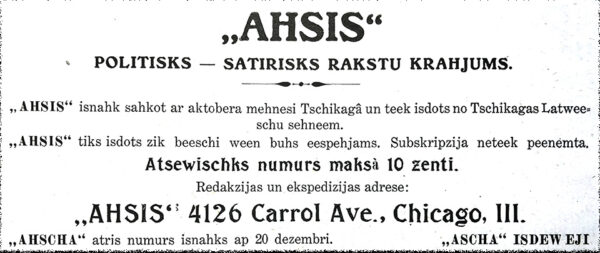Over the years, I have had the opportunity to collect details, and in some cases even samples, of most of the various periodicals published by early 20th century Latvian immigrants and their descendants in the United States. But two publications, both produced in Chicago before World War I, remain largely a mystery.
One, called Apskats (The Review), was published beginning probably in January or February 1914 and lasted until at least May of that year. I came across it years ago in the collection of the Chicago Latvian Society’s library, which had inherited various pre-World War II materials from the early immigrants. The other publication, Āzis (The Billy-Goat), has yet to be uncovered, although the periodical was referred to in a 1909 edition of the satirical Philadelphia-based journal Pērkons (Thunder), which also carried an advertisement for it.
The comprehensive 1977 guide to Latvian newspapers, magazines, and other serial publications, Latviešu periodika1, has no mention of Āzis and notes only two passing references to Apskats2. Regarding Apskats, the guide does not list it as available in any of the main state libraries in Latvia.
Apskats
The 1929 guide to Latvian holdings in the Chicago Public Library prepared by Jānis Šmits reported that Apskats was in that institution’s collection3. However, it likely was lost or discarded long ago.

It is clear that the publisher of Apskats wanted to create a good quality publication, a “social, scientific and literary monthly.” The journal was typeset, as opposed to using a less expensive technology like the hectograph. The contents included political and social commentary, poetry, humor, translations of essays and plays4, as well as theater reviews. However, the issues I have seen were in a bound volume, so it is not possible to tell whether the periodical originally had a cover or whether it really did not list the name of the editor or any other staff information. Not even an address can be found.
The contents suggest that politically Apskats supported the aspirations of Latvian workers, although it did not seem to align with either the Socialist Party of America or the Socialist Labor Party, both of which had Latvian branches in Chicago. In one issue, the editor of Apskats published a response to a critique of the journal by Strādnieks, the official newspaper of the National Lettish Organization (i.e., koporganizācija) of the Socialist Party.5 Not surprisingly, the critique had attacked Apskats in part because it did not toe the national organization’s line, a complaint often leveled at rival publications no matter how small they might be.
Apskats also noted its difficulties in reaching potential readers in Chicago. During a May Day celebration held in 1914 and hosted by the Chicago Latvian local of the Socialist Party, organizers had refused to allow Apskats to be sold at the event.6
Āzis
While much is yet to be learned about Apsakts, it is Āzis that has proven to be the bigger challenge. I have yet to locate a single copy of it, although I am sure that the periodical existed.
The editor of Pērkons noted receiving a copy of the first issue, dated October 19097. Āzis was described as a collection of political satire printed with a hectograph. The address for editorial and business affairs was listed as 4126 Carroll Avenue in Chicago. Yet even this detail so far has been of little assistance in learning any more about the publication. An advertisement for Āzis that appeared in Pērkons hasn’t helped, either. The periodical, according to the ad, was published by a group of Chicago Latvian men. Āzis was to be published “as often as possible,” with the next issue planned for December 20, 1909. Subscriptions were not accepted.

I can speculate that in its character, Āzis may have been similar in tone to Pērkons, which questioned the discipline of the National Lettish Organization of the Socialist Party. In the small universe that was the radical political movement among Latvian immigrants in the pre-World War I era, efforts by the koporganizācija to maintain unity were continually challenged by various voices. Āzis likely was among them.
1. K. Brempele et al., eds., Latviešu periodika, 1. sējums, 1768-1919 (Rīga: Zinātne, 1977).
2. References to Apskats were found in the February 27, 1914, edition of Strādnieks and in the 1920 collection of Latvian-American proletarian literary works, Nemiers, according to Latviešu periodika, p. 30.
3. Chicago Public Library, Latvian Books: Čikāgas Publiskās Bibliotekas latviešu grāmatas (Chicago: Chicago Public Library, 1929), p. 1.
4. One of the translations that appears serialized in Apskats is of “The Devil,” a play by the Hungarian writer Ferenc Molnár. It was translated to Latvian as “Velns” by J. Apsītis-Dukats and released in book form in 1914 by the Chicago publisher Dzirkstele.
5. “Laikrakstu apskats,” Apskats, 1:2(March 1914), 54-55.
6. “Mūsu pašu starpā,” Apskats, 1:4(May 1914), 119.
7. “Grāmatu galds,” Pērkons, No. 3 (1909), p. 38.
Accessed on 23 Apr 2024.
The article may be found online at https://straumanis.com/2019/two-periodicals-remain-mystery/.
